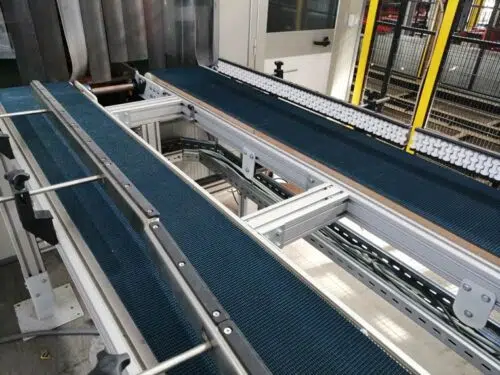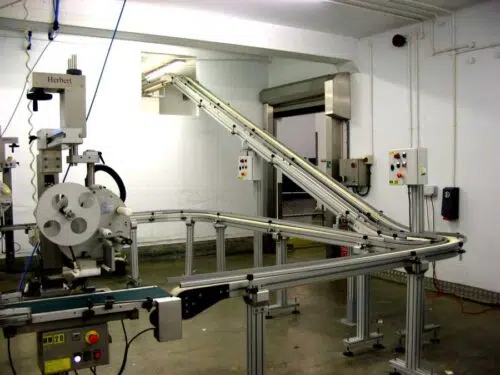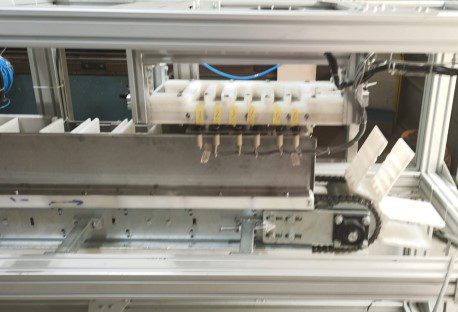Abstract
Automation has become a linchpin of industrial transformation across Egypt and the wider Middle East. This article delivers an in‑depth, journal‑style survey of automation solutions, with emphasis on conveyor systems, the types of conveyors used, the role of outsourcing in delivering these solutions, economic and technical insights, and a Q&A section to engage readers.
1. Introduction: Rise of Automation in Egypt & the Middle East
Over the past decade, Egypt, GCC countries, and other economies in the Middle East have accelerated the adoption of industrial automation to boost productivity, optimize costs, and comply with global standards. Leading firms such as ENTRA in Egypt are designing and delivering integrated conveyor‑based solutions tailored for industries ranging from logistics and food to pharmaceuticals and automotive
With outsourcing—from design to deployment—becoming increasingly common, regional manufacturers and integrators now offer end‑to‑end packages that include conveyors, control systems (PLC, SCADA, IoT monitoring), integration, and support. This outsourcing model allows industrial operators to benefit from advanced solutions without maintaining full in‑house engineering teams.
2. Conveyor Systems: Backbone of Material‑Handling Automation
2.1 What Are Conveyor Systems?
Conveyors are mechanical systems designed to transport materials or products from one point to another via belts, rollers, chains, screws, air ducts, or overhead tracks. In automated factories and warehouses, conveyors dramatically reduce human labor and load/unload times, enhancing throughput, safety, and accuracy
2.2 Common Types of Conveyor Systems
2.2.1 Belt Conveyors
The most prevalent type worldwide, consisting of a continuous loop belt powered by drive and tail pulleys. They are flexible, configurable for curves or inclines, and suited to light‑to‑medium loads. Belt material options include rubber, PVC, and modular plastic belts—often chosen for food‑grade or hygiene‑sensitive applications
2.2.2 Roller Conveyors
Consist of motorized or gravity rollers, ideal for boxes, cartons, or pallets. Roller conveyors excel in logistics, shipping zones, and buffering operations. Heavy‑duty roller lines can handle weights above 500 lbs
2.2.3 Chain Conveyors
Chain‑driven systems for heavy or awkward loads. They include apron, drag, flight, scraper, and en‑masse chain conveyors. Widely used in automotive lines, heavy goods, painting/coating processes, and bulk material movement
2.2.4 Screw Conveyors (Auger Conveyors)
A rotating helical screw moves bulk powdery or granular materials within a tube. Ideal for grains, flours, chemicals, and other bulk solids requiring enclosed, controlled handling
2.2.5 Pneumatic Conveyors
Use air pressure or vacuum pipelines to transport powdered or granular materials in a sealed duct system—ensuring hygiene and containment. Common in food, pharmaceutical, cement, and chemical sectors ويكيبيديا+15
2.2.6 Overhead Conveyors
Track-mounted systems where items hang from trolleys. Excellent for paint lines, garment handling, assembly operations—freeing floor space and enabling high throughput flow
2.2.7 Vibrating Conveyors
Use vibrating troughs or pans to transport dry bulk solids. They’re widely used where sanitation matters, or for extreme environments and incline conveying up to 45° ويكيبيديا.
2.2.8 Flexible & Modular Conveyors
Made of plastic or metal modules and multi‑flexing chains. Highly configurable—curves, inclines, and reconfigurable paths. Popular in food, beverage, pharma, and packaging lines ويكيبيديا.
2.2.9 Advanced / Smart Conveyors
New systems include cross‑belt sorters—with independent transverse belts that sort items at high speed using induction or linear motors—used in parcel/logistics hubs ويكيبيديا.
An experimental frontier: AI‑based Maglev conveyors, employing magnetic levitation and real‑time AI control to reduce friction, maintenance, and cycle time—while enabling ultra‑clean, high‑speed transport for precise parts assembly
2.3 Integration of Conveyors into Automation Solutions
Modern conveyor systems are no longer standalone mechanical devices—they are integrated into smart automation platforms:
Controlled via PLC and SCADA systems
Monitored by IoT sensors, RFID, barcode/RFID scanning
Integrated with robotic pick‑and‑place, sortation modules, and automated storage/retrieval systems (ASRS)
Scalable control and data visualization for maintenance, productivity tracking, and predictive diagnostics
Regional integrators like ENTRA (Egypt) offer conveyors along with IoT‑enabled control and support for full facility automation . manufactures modular conveyor lines for agriculture, food processing, packaging, and assembly industries—with outsourced design, installation, and post‑deployment service contracts
3. Automation Solutions & Outsourcing Models in Egypt / Middle East
3.1 Why Outsource Automation Projects?
Egypt-based operators and regional industrial groups often outsource conveyor automation projects because:
Access to expert engineering: local integrators bring mechanical, electrical, and software expertise.
Reduced CAPEX risk: modular solutions that can grow.
Faster deployment compared to building in-house systems.
Service & maintenance contracts ensure uptime, spare parts, and upgrades.
Localization: Egyptian integrators like ENTRA and provide support and know regional regulatory standards.
3.2 Key Outsourcing Providers / Partners
ENTRA Electromechanical Conveyors: offers end-to-end conveyor automation, control system integration, custom material handling tailored to logistics, manufacturing, mining, food, pharma sectors across Egypt and MENA region
Various other GCC‑based firms (UAE, Saudi)—such as ATCO Business Solutions and SMARTLOGITECX—also offer turnkey conveyor automation systems for regional clients, covering belt, modular, roller, sorting, and vertical conveyors
3.3 Example Implementation Flow (Outsourced Project)
Needs Assessment: site visit and requirement gathering (product types, throughput, hygiene, space constraints).
Design & Engineering: conveyor selection (belt/roller/chain/screw), layout design, integration points, control system design.
Sourcing & Manufacturing: local fabrication of steel frames, modular belts, chain conveyors; belts from partners like Habasit
Installation & Integration: mechanical assembly, wiring, PLC/SCADA setup, robot/sorter linking, HMI setup.
Testing & Commissioning: load tests, safety interlocks, throughput verification.
Training & Handover: operator training, documentation, maintenance schedules.
Support & Scaling: service contracts, upgrades, remote monitoring, spare parts.
4. In‑Depth Types of Conveyors Used in Middle East Automation
Let’s review each conveyor type, technical details, and typical applications in the region:
4.1 Belt Conveyors

Materials: PVC, rubber, modular plastic belts for hygiene compliance, FDA certification available from local providers (e.g. UAE/Egypt)
Layouts: straight, incline, decline, curved, trough belts.
Applications: logistics, warehousing, packaging, mining, SME manufacturing.
Advantages: versatile, scalable, continuous flow, low noise, easy to clean.
4.2 Roller Conveyors

Types: gravity roller (sloped, no power) and powered motorized roller conveyors (including motorized drive roller—MDR with embedded BLDC motors) for zones handling up to ~35 kg loads
Special variants: curve roller conveyors, pop‑up diverters, zero-pressure accumulation zones, pallet roller conveyors for heavy‑duty pallets
4.3 Chain Conveyors

Types: apron conveyors, drag conveyors, flight conveyors, scraper conveyors, en‑masse conveyors. Designed for heavy/harsh environments: pallets, barrels, automotive parts, clinker, sawdust, etc ويكيبيديا.
Variants: table‑top chain, slat chain, heavy‑duty industrial chain.
Applications: automotive assembly, metal finishing, distribution centers, paint plants.
4.4 Screw Conveyors
Functional Detail: screw rotates within a trough or tube, propelling bulk solids. Horizontal, inclined, vertical configurations available.
Applications: food processing (grains, sugar), chemical plants, cement, feed mills. Precise flow control and dust reduction are key benefits.
4.5 Pneumatic Conveyors
Design: enclosed line conveying using positive pressure or vacuum. Keeps materials hygienic and contained.
Applications: pharmaceutical powders, chemical powders, fine cement, food powder handling.
4.6 Overhead Conveyors
Design: hanging trolley track.
Applications: garment finishing lines, paint booths, automotive part transport. Ideal when floor space is restricted and items must stay off the ground.
4.7 Vibrating Conveyors
Design: vibratory trough or tube.
Applications: conveying hot or dry bulk solids, screening/sorting, environments with washdown needs (food, metal foundries)
4.8 Flexible / Modular Conveyors
Design: modular plastic links sliding on wear strips, flexible paths.
Applications: food, beverage, pharmaceutical, packaging. Good for layouts that need frequent reconfiguration
4.9 Cross‑belt Sorter Systems
Used in high-speed parcel sorters: independent short belts on carriers that discharge items sideways at sort points. Ideal for logistics, e‑commerce, airlines, and postal hubs. They often use linear motors or induction drives and integrate scanning systems (barcode, RFID) ويكيبيديا.
4.10 AI‑Maglev Conveyors (Research / Emerging)
Incorporate magnetic levitation and AI‑driven controls for frictionless, speedy, silent conveyors with minimal maintenance. Currently experimental but representing a future vision for Middle East smart factories
5. SEO Insights: Keywords and Phrases That Matter
To attract readers and search engines, here are key themes and target phrases to weave naturally:
automation solutions Egypt, conveyor systems Egypt, industrial automation Middle East
outsourced automation services Egypt, automation outsourcing Egypt, turnkey conveyor automation
types of conveyors Middle East, belt conveyor Egypt, modular conveyors Egypt, chain conveyors automotive Egypt
smart conveyors Middle East, IoT automation Egypt, cross belt sorter logistics Egypt, AI‑Maglev conveyor future.
6. Q&A Section
Q1: What types of conveyors are most suitable for food and pharmaceutical industries in Egypt?
A: Typically modular link conveyors with FDA‑approved plastic belts, belt conveyors with PVC or polyurethane belts for hygiene, and pneumatic conveyors when handling powders. Suppliers like ENTRA offer these specific conveyor types with cleanable surfaces and certifications
Q2: Can Egyptian manufacturers avoid in‑house automation by outsourcing?
A: Yes—companies commonly outsource automation design, fabrication, installation, and maintenance to integrators like ENTRA . This is efficient, cost-effective, and reduces technical burden while ensuring support and scalability.
Q3: What conveyor type fits heavy load applications like pallets or barrels?
A: Chain conveyors (flight, drag, apron types) and heavy‑duty roller conveyors handle loads well over 500 lbs. Motorized pallet rollers, chain conveyors with sprockets, and apron chain types are tailored for high weight and rugged conditions
Q4: Are sophisticated sorter conveyors (e.g. cross‑belt sorters) available in Egypt/Middle East?
A: Yes—logistics hubs, parcel shipping centers, and airports are implementing cross‑belt sorters, integrating scanning systems and linear induction motors via local systems providers or international suppliers in the region ويكيبيديا.
Q5: What is the future of conveyors in the region?
A: Emerging technologies such as AI‑Maglev conveyors, IoT‑connected smart systems, and modular, reconfigurable designs will shape modern smart factories. Ongoing R&D and pilot projects, like the Maglev system, are paving the way
7. Insights & Best Practices
✅ System Design & Layout Optimization
Analyze product dimensions, weight, throughput, incline, curve, hygiene, and environmental conditions.
Use modular conveyors for adaptability.
✅ Integration with Control Systems
Employ PLC, SCADA, and IoT sensors for central control and visibility.
RFID/barcode scanning allows real-time tracking and traceability.
Consider predictive maintenance modules to reduce downtime.
✅ Outsourcing as a Strategic Advantage
Outsourcing to local integrators reduces cost and risk.
Opt for providers with experience in the local context and after-sales support.
✅ Maintenance & Training
Ensure planned maintenance schedules and spare parts.
Operator training and clear documentation are essential.
✅ Cost & ROI
Initial CAPEX vs long-term OPEX savings.
Conveyor systems lower labor cost, improve throughput, reduce error and downtime—delivering rapid ROI when integrated effectively.
8. Journal‑Style Case Study: Conveyor Automation in a Food Packaging Plant (Hypothetical Example)
Background: A multinational food company in Egypt operates a processing line requiring rapid, hygienic handling of packaged snacks.
Solution by Outsourced Integrator (e.g. ENTRA):
Installed modular belt conveyors with FDA‑approved belts for hygiene and washdown.
Upstream bulk grain moved by screw conveyors, pneumatically transferred powders.
Sorting conveyor network uses pop‑up diverter/curve roller conveyors into packing and palletizing stations.
Control system integrated with PLC/SCADA, barcode scanning for traceability, IoT sensors monitoring belt health.
Maintenance contract and spare‑parts stock maintained by integrator.
Outcome:
Throughput increased by 50%
Labor hours reduced by 30%
Product rejects cut by 20%
Downtime minimized to under 2 % unplanned per month
9. Call‑to‑Action for Readers
If you’re planning an automation project in Egypt or the Middle East—from warehousing to manufacturing or logistics—here’s your action path:
Define your application requirements: industry, product types, weight, hygiene.
Evaluate conveyor types (belt, roller, chain, screw, pneumatic).
Seek local integrators with proven track records (ENTRA, regional partners).
Request turnkey proposals including design, integration, training, and long‑term support.
Ensure solutions are scalable, smart (IoT/PLC), and future‑proof for Industry 4.0.
10. Conclusion
Automation in Egypt and the Middle East is growing fast, driven by demand for efficient, cost‑effective material handling. Conveyor systems—belt, roller, chain, screw, pneumatic, vibratory, overhead, modular, and advanced sorters—form the backbone of these solutions. Outsourcing design and deployment provides flexibility, expertise, and lower risk for industrial clients.
By understanding conveyor types, design strategies, and the leading integrators in the region, readers gain the confidence to explore and implement robust automation solutions that scale with business needs.

